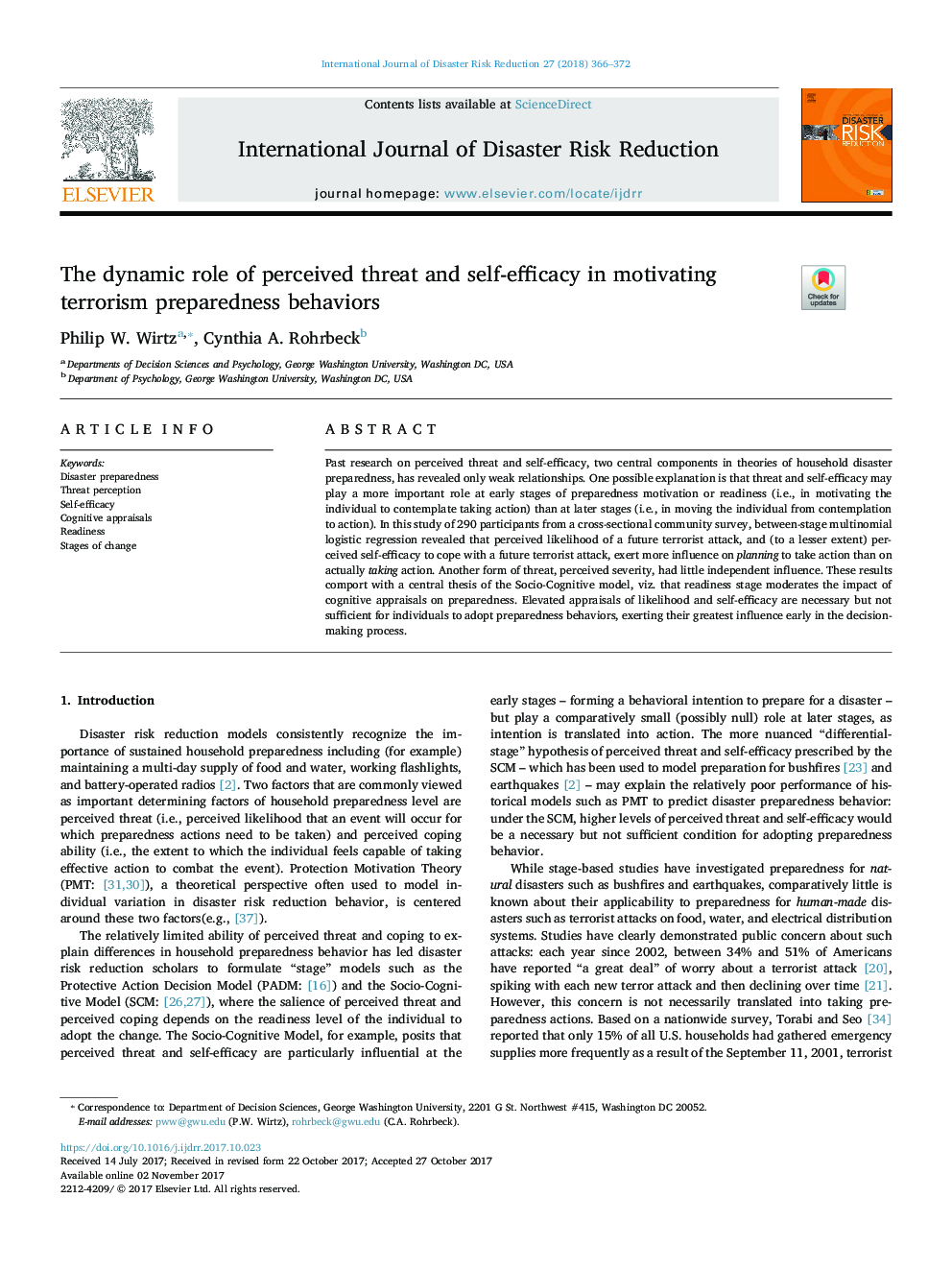| کد مقاله | کد نشریه | سال انتشار | مقاله انگلیسی | نسخه تمام متن |
|---|---|---|---|---|
| 7471991 | 1485143 | 2018 | 7 صفحه PDF | دانلود رایگان |
عنوان انگلیسی مقاله ISI
The dynamic role of perceived threat and self-efficacy in motivating terrorism preparedness behaviors
ترجمه فارسی عنوان
نقش پویای تهدید درک شده و خودکارآمدی در ایجاد انگیزه های رفتار آماده سازی تروریسم
دانلود مقاله + سفارش ترجمه
دانلود مقاله ISI انگلیسی
رایگان برای ایرانیان
کلمات کلیدی
آمادگی بلایا، درک تهدید، خود کارآمدی، ارزیابی های شناختی، آمادگی مراحل تغییر،
ترجمه چکیده
تحقیقات گذشته در مورد تهدید درک شده و خودکارآمدی، دو جزء مرکزی در نظریه های آمادگی در فاجعه خانگی، تنها روابط ضعیف را نشان داده است. یک توضیح احتمالی این است که تهدید و خود کارآیی ممکن است نقش مهمی در مراحل اولیه انگیزه آمادگی یا آمادگی (به عنوان مثال در انگیزه فرد برای در نظر گرفتن اقدامات) بازی کند تا در مراحل بعدی (یعنی در حرکت فرد از تفکر به عمل). در این مطالعه از 290 شرکت کننده از یک بررسی جامعه مقطعی، رگرسیون لجستیک چند مرحله ای میان مرحله ای نشان داد که احتمال بروز یک حمله تروریستی در آینده و (به حداقل رساندن) خود کارآیی درک شده برای مقابله با یک حمله تروریستی آینده، اعمال تأثیر بیشتر بر برنامه ریزی برای انجام اقدامات نسبت به اقدام واقعی. شکل دیگری از تهدید، شدت درک شد، نفوذ مستقل کمی داشت. این نتایج با یک تئوری مرکزی از مدل اجتماعی-شناختی، یعنی. این مرحله آمادگی، تأثیر ارزیابی های شناختی بر آمادگی را تعدیل می کند. ارزیابی های بالقوه احتمال و خودکارآمدی ضروری است، اما برای افرادی که رفتارهای آمادگی را اتخاذ می کنند، کافی نیست، و بیشترین تأثیر را در مراحل اولیه تصمیم گیری دارند.
موضوعات مرتبط
مهندسی و علوم پایه
علوم زمین و سیارات
فیزیک زمین (ژئو فیزیک)
چکیده انگلیسی
Past research on perceived threat and self-efficacy, two central components in theories of household disaster preparedness, has revealed only weak relationships. One possible explanation is that threat and self-efficacy may play a more important role at early stages of preparedness motivation or readiness (i.e., in motivating the individual to contemplate taking action) than at later stages (i.e., in moving the individual from contemplation to action). In this study of 290 participants from a cross-sectional community survey, between-stage multinomial logistic regression revealed that perceived likelihood of a future terrorist attack, and (to a lesser extent) perceived self-efficacy to cope with a future terrorist attack, exert more influence on planning to take action than on actually taking action. Another form of threat, perceived severity, had little independent influence. These results comport with a central thesis of the Socio-Cognitive model, viz. that readiness stage moderates the impact of cognitive appraisals on preparedness. Elevated appraisals of likelihood and self-efficacy are necessary but not sufficient for individuals to adopt preparedness behaviors, exerting their greatest influence early in the decision-making process.
ناشر
Database: Elsevier - ScienceDirect (ساینس دایرکت)
Journal: International Journal of Disaster Risk Reduction - Volume 27, March 2018, Pages 366-372
Journal: International Journal of Disaster Risk Reduction - Volume 27, March 2018, Pages 366-372
نویسندگان
Philip W. Wirtz, Cynthia A. Rohrbeck,
